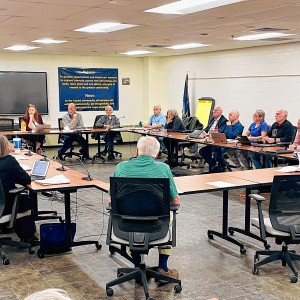Proposed Greenville treatment center to go to regional hearing
| Published: 12-12-2022 11:14 AM |
Neighboring towns will have the opportunity to weigh in on the possible regional impacts of a proposed drug- and alcohol-treatment facility proposed to be developed in the existing Chamberlin Mill in Greenville, which abuts the Souhegan River.
The Planning Board held its first official hearing on the proposal Wednesday, although developers had already done an initial review of the proposal with the board during a conceptual review.
During the hearing, Chair Michael Sadowski informed audience members the board would not likely get to the point of collecting public comment on Wednesday, first having to review the application for completeness and regional impact.
Ultimately, the board found that there was possible regional impact, mainly in the areas of the need for mutual aid assistance in responding to potential emergencies at the facility, and its proximity to the Souhegan River.
“This certainly, to us, has regional impact,” Sadowski said. “For a few reasons. We don’t have the resources to support it, with part-time fire and police. We are so small, anything really big that comes here is going to have regional impact.”
Planning Board member Scott Tenney noted that the town does not have 24-hour police coverage, and shares its department with Temple, and only has a volunteer fire company.
“We rely heavily on mutual aid from our surrounding towns,” Tenney said.
Because the project was found to have regional impact, neighboring towns are considered abutters and will be notified as such prior to future discussions, and given the opportunity to submit comment.
Article continues after...
Yesterday's Most Read Articles
 Peterborough voters approve funds for fire and rescue station
Peterborough voters approve funds for fire and rescue station
 HOMETOWN HEROES – Rose Novotny is motivated by community
HOMETOWN HEROES – Rose Novotny is motivated by community
 Mt. Monadnock Little League celebrates opening day
Mt. Monadnock Little League celebrates opening day
 ConVal committee begins to study withdrawal process
ConVal committee begins to study withdrawal process
 Mascenic custodian named statewide 'Champion for Children'
Mascenic custodian named statewide 'Champion for Children'
 L. Phillips Runyon III – Personal freedom and the common good
L. Phillips Runyon III – Personal freedom and the common good
The board did begin its review on Wednesday, with Christopher Foster, an operational consultant on the project, and David Eckman of Eckman Engineering presenting for applicant Georges Realty.
Foster explained the intent was to develop the building, located at 21 Chamberlin St., in the downtown district, into a drug- and alcohol-treatment center for patients who were intended to stay between 60 and 90 days for in-patient treatment.
Foster said those getting treatment at the facility would be there voluntarily, and had to ability to discharge themselves.
Eckman said the three-story building would include a kitchen and therapy offices in the lowest floor, with rooms and beds mostly on the second floor.
The facility is proposed to include 35 patient units, 31 of which would include two beds, for a total of 66 beds.
The board's initial questions focused on the issue of parking and snow removal around the facility, which has space for individual parking spaces around the building, but does not have a large parking lot.
Patients would not be allowed to park cars at the facility, explained Foster. There would be a scheduled check-in time when the client was dropped off, usually by a family member or friend.
Most of the parking spaces would be used by the staff at the facility, with a total of 53 positions expected and as many as 28 employees on-site at the same time. The site itself only has 15 proposed parking spaces – two of which would be double-parked, which the board pointed out is not likely to be approved.
Georges Realty has an agreement with a nearby church for up to 20 spaces, with an agreement for a lease for the next 10 years and an option to renew for another 10 years afterwards.
Despite the length of the lease, the board said they both wanted a more permanent agreement and to ensure that the parking requirements for the church were still served if all 20 spaces were in use by the treatment facility.
The board did not vote on the completeness of the application on Wednesday, instead voting to request a third-party review of the application to check for completeness, a process unusual for Greenville, but that the board though appropriate given the scope of the development.
The board continued the completeness review until Jan. 12 at 7 p.m. in the Greenville Town Hall Meeting Room.
In a separate hearing on Wednesday, the board directed a developer proposing the conversion of the former Antiques Mall of New England on Dunster Avenue into apartments to obtain several variances from the Zoning Board of Adjustment.
The variances include a variance for the number of apartments, which cannot exceed six, where the application calls for 11, the town’s green space requirements and a requirement that in multistory buildings there be no dwelling units on the bottom floor.
The hearing on the application was continued until Feb. 9.






 Zoning proposal fails
Zoning proposal fails Vehicle rolls over on Route 31 in Greenfield
Vehicle rolls over on Route 31 in Greenfield PHOTOS: Peterborough hosts Children and the Arts celebration
PHOTOS: Peterborough hosts Children and the Arts celebration Superintendent Kimberly Rizzo Saunders leaving ConVal School District
Superintendent Kimberly Rizzo Saunders leaving ConVal School District
